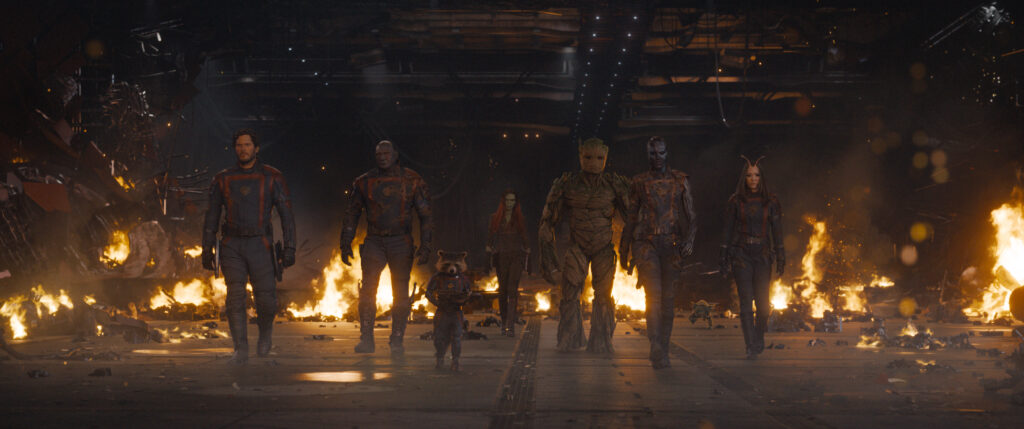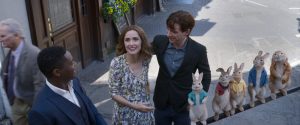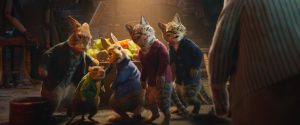April 28, 2023
by Carla Hay

“Guardians of the Galaxy Vol. 3”
Directed by James Gunn
Culture Representation: Taking place in various parts of the universe, the sci-fi/fantasy/action film “Guardians of the Galaxy Vol. 3” (based on Marvel Comics characters) features a cast of characters as humans and other creatures.
Culture Clash: Superhero crimefighters Guardians of the Galaxy fight to save a seriously wounder member, as they also battle against a villain who wants to create perfect beings in a perfect society.
Culture Audience: Besides appealing to the obvious target audience of Marvel movie fans, “Guardians of the Galaxy” will appeal primarily to people who are fans of the movie’s headliners and superhero movies that are the equivalent of having attention-deficit disorder.

People who watch Marvel Studios’ “Guardians of the Galaxy Vol. 3” might need a neck brace from all the tonal whiplash and messy editing that viewers will get from this mixed bag of a superhero film. It clumsily tries to blend mean-spiritedness with sentimentality. The new characters in this saga are hollow and horribly written. Most of the returning hero characters are often smug and irritating, losing much of the charm that they had in the first two “Guardians of the Galaxy” movies: 2014’s “Guardians of the Galaxy” and 2017’s “Guardians of the Galaxy Vol. 2.” These two previous films are necessary to watch, in order to understand a lot of what’s going on in “Guardians of the Galaxy Vol. 3.”
Written and directed by James Gunn (who wrote and directed the first two “Guardians of the Galaxy” movies), “Guardians of the Galaxy Vol. 3” has sloppy storytelling that is very off-putting to viewers who are expecting that this third film in the series would be the best, since it’s supposed to wrap up a trilogy storyline. Unfortunately, “Guardians of the Galaxy Vol. 3” is the worst movie of the first three “Guardians of the Galaxy” movies. Maybe it’s because Gunn finished working on “Guardians of the Galaxy Vol. 3” when he knew he was going to be co-chairman and co-CEO of DC Studios, the longtime biggest rival of Marvel Studios. The Walt Disney Company, which owns Marvel Studios, famously fired Gunn from “Guardians of the Galaxy Vol. 3” in 2018, because of vulgar jokes that he told on Twitter and elsewhere, but then Disney re-hired Gunn for the movie in 2019.
No matter what anyone says, when the chief filmmaker is also working for the competition, that conflict of interest had to affect filmmaking choices that were made for “Guardians of the Galaxy Vol. 3.” It shows in how the movie has a “got to fulfill the contract obligations before I leave” tone to it. And that’s not just with the writing and directing. Some of the cast members look a little tired of playing these characters, because they don’t have as much spark or enthusiasm as they had in the previous “Guardians of the Galaxy” movies.
Pity anyone who hasn’t seen the first two “Guardians of the Galaxy” films, because “Guardians of the Galaxy Vol. 3” barely gives any crucial background information to viewers who don’t know what happened in those first two movies. But that’s not the main problem of “Guardians of the Galaxy Vol. 3.” With the exception of one standout fight scene (shown in slow-motion), the rest of the action scenes are scatter-brained and unimpressive. They’re staged with the idea that a lot of gun shooting and explosives are enough to make an action scene.
And speaking of scenes shown in slow-motion, how many times do we need to see the “heroes” walking together in slow-motion, as if they own the universe? Apparently, once is not enough in “Guardians of the Galaxy Vol. 3,” because this type of cliché is used at least four times in the movie. It’s also so tiresome and unimaginative.
“Guardians of the Galaxy Vol. 3” also requires that people know what happened in 2018’s “Avengers: Infinity War,” because Guardians of the Galaxy leader Peter Quill/Star-Lord (played by Chris Pratt), who is originally from Earth, uses it as a reason to get drunk, be obnoxious, and generally have an angry attitude problem. The fun-loving Peter from the first two “Guardians of the Galaxy” movie is mostly gone. He’s now a bitter whiner who’s often on a rampage. (Peter does some cursing and rage-filled violent acts that might surprise some viewers expecting this movie to be more “family-friendly.”)
Peter has changed for the worse because he’s grieving over the loss of his true love/soul mate Gamora (played by Zoë Saldaña), who (mild spoiler alert) died in “Avengers: Infinity War.” But because “Guardians of the Galaxy Vol. 3” is a Marvel movie, multiverses can have different versions of the same character. And so, for “Guardians of the Galaxy Vol. 3,” an alternate version of Gamora (also played by Saldaña) has been “found” by her adoptive sister Nebula (played by Karen Gillan), who has had a love/hate relationship with Gamora for years. In “Guardians of the Galaxy Vol. 3,” this “alternate” Gamora is a Ravager (a space pirate), but she helps the Guardians of the Galaxy when they go on a mission to stop an evil villain and to save the life of a fellow Guardian.
The other members of the Guardians of the Galaxy are hulking oaf Drax (played by Dave Bautista), whose brawn power far exceeds his brain power; raccoon mutant Rocket (voiced by Bradley Cooper), a sarcastic daredevil pilot, who can move like a human; compassionate empath Mantis (played by Pom Klementieff), who has the power to control minds; and shapeshifting tree creature Groot (voiced by Vin Diesel), who only says these three words when he talks: “I am Groot.” In the first two “Guardians of the Galaxy” movies, the chemistry between all of these characters was believable. In “Guardians of the Galaxy Vol. 3,” the chemistry between these characters is disjointed and undermined by awkward jokes.
The beginning of “Guardians of the Galaxy Vol. 3” shows Peter in a drunken stupor. He’s so drunk, he’s passed out, and Nebula has to carry him. Peter snaps out of his self-pitying alcohol abuse when something terrible happens: A golden-hued stranger from outer space named Adam Warlock (played by Will Poulter) has barreled into the Guardians’ territory by literally crashing through a window into Rocket. Adam, who has the power to quickly heal from any wounds, has come to attack. The rest of the Guardians rush to Rocket’s defense.
A big fight ensues that results in Adam retreating back to his world, but Rocket is critically injured from Adam’s stab to Rocket’s chest. During the frantic attempts to save Rocket’s life, the Guardians find out that Rocket has an internal kill switch that is set to take Rocket’s life in a little more than 40 hours. It’s surprising information to Rocket’s Guardians of the Galaxy friends, because Rocket has told them very little about his past.
The best part of “Guardians of the Galaxy Vol. 3” is the deep dive into Rocket’s past, shown as several flashbacks in the movie. He was captured as a baby and forced to live in a cage in a dark and dingy room at a scientific lab. Rocket’s name back then was Subject 89P13, often called P13 for short. As he grew up, he became friends with three other mutant creatures who were also imprisoned in this lab: Lylla (voiced by Linda Cardellini), an intelligent otter with mechanical arms; Teefs (voiced by Asim Chaudhry), a wheelchair-using walrus; and Floor (voiced by Mikaela Hoover), a mild-mannered and somewhat goofy rabbit who wears a metal muzzle.
The chief villain in the movie is the High Evolutionary (played by Chukwudi Iwuji), a stereotypical “mad scientist,” who wants power over how the universe works. In the movie, he says he has a “simple quest: create the perfect species and the perfect society.” Of course, this quest isn’t so “simple,” because the High Evolutionary has been sending his minions across the universe to find beings to capture and use for experiments. You don’t need to have highly evolved intelligence to figure out why Adam attacked Rocket.
The Guardians are now in a race against time to save Rocket’s life. They zip around on their new ship called the Bowie and get into various battles. The High Evolutionary does a lot of sneering and smirking, but he’s not in the upper echelon of Marvel’s most fearsome villains. The High Evolutionary has two main sniveling sidekicks: Recorder Vim (played by Miriam Shor) and Recorder Theel (played by Nico Santos), who follow the High Evolutionary’s orders out of fear, even though this villain isn’t all that scary. Recorder Vim is smart and outspoken, unlike Recorder Theel who doesn’t seem capable of processing an independent thought in his head.
Many of the fight scenes are nonsensical and look too fake. For example, there’s a scene where one of the Guardians sets off a huge bomb in a room with villains and other Guardians in the same room when the bomb goes off. It looks incredibly stupid to set off a bomb when you and your allies could be maimed or killed too. Bombers who know what they’re doing always make sure they’re far away from the bomb when it’s detonated, unless they’re suicide bombers. You don’t have to be a bomber to know that. It’s just common sense.
And there are too many fight scenes where the Guardians unrealistically don’t get the types of serious injuries that would happen if these fight scenes had more authenticity. Unlike other superhero groups, the Guardians of the Galaxy don’t have any phenomenal powers except above-average strength, Mantis’ mind-control abilities, and Groot’s ability to shapeshift. In the case of Peter, the only human in the Guardians of the Galaxy, all he has are his abilities to use weapons and any fight skills using his body.
The Guardians end up on an alternative version of Earth called Counter-Earth. It’s a missed opportunity to show a very fascinating world. Instead, Counter-Earth is just another place where the Guardians do some not-very-funny slapstick comedy, many of it involving children. The people of Counter-Earth have creature heads that look like less-gruesome versions of what writer/director Gunn used to work with during the years he was affiliated with the low-budget horror studio Troma.
Adam’s presence in the movie is erratic. He’s not seen for a long stretch of the movie, and then he comes back again toward the end for a big brawl. The movie can’t make up its mind if it wants Adam to be a muscle-bound menace or a sympathetic sap who’s the victim of the High Evolutionary. Adam’s mother Ayesha is portrayed by Elizabeth Debicki, a very talented actress whose role in this movie is shamefully shallow, thereby squandering her talent and the chance for Ayesha to be a fascinating character. Viewers will have a hard time remembering any lines of dialogue that Ayesha says in “Guardians of the Galaxy Vol. 3,” but she sure scowls a lot.
Other characters flit in and out of the movie, like insects that buzz around and have no real purpose. Maria Bakalova is the voice of a Russian astronaut dog character named Cosmo, which is a cute but not essential character. The running gag for Cosmo is she feels misunderstood and insecure because she keeps getting told she’s a “bad dog,” when she’s really a good dog.
Sylvester Stallone is in the film for a total about five minutes in two scenes in “Guardians of the Galaxy Vol. 3,” as Ravager captain Stakar Ogord. It’s another non-essential role that looks like a “contract obligation” cameo. The Stakar character was much more interesting in “Guardians of the Galaxy Vol. 2.” Sean Gunn (James Gunn’s younger brother) reprises his role as Kraglin, an ally of the Guardians. Kraglin has a big moment in the movie that looks like a decision made from pure nepotism, because any other director probably wouldn’t have given Kraglin this type of scene.
Rocket is the only Guardians of the Galaxy member who has character development in “Guardians of the Galaxy Vol. 3.” Everyone else just seems to be going through the motions. And don’t expect there to be any sizzling romance in this movie. A lovelorn Peter tells “alternate” Gamora that they used to be a hot couple in love, but she coldly cuts him off and says that the Gamora he was with was “an alternate, future version of me.”
“Guardians of the Galaxy Vol. 3” tries to cram in a lot of sentimentality and nostalgia in the last 15 minutes of the film. A few characters who died in previous Marvel films are briefly seen as visions or flashbacks. Toward the end of the film, Peter also does something that is blatantly intended to get viewers to cry.
It all seems very manipulative and forced though, considering some of the crude and unfunny things that this 150-minute movie wasted time shoving in viewers’ faces. And some of these scenes get monotonous, especially in the middle of the film. The mid-credits scene is unremarkable, while the end-credits scene assures viewers that a “legendary” character in the “Guardians of the Galaxy” series will continue in the Marvel Cinematic Universe in a major way.
One area where “Guardians of the Galaxy Vol. 3” does not disappoint is in the movie’s soundtrack song choices. Songs such as Rainbow’s “Since You Been Gone,” Radiohead’s “Creep,” Spacehog’s “In the Meantime,” Beastie Boys’ “No Sleep Till Brooklyn,” Faith No More’s “We Care a Lot” and Florence + the Machine’s “Dog Days Are Over” (which is in the movie’s biggest emotion-tugging scene) are all well-placed and used to maximum effect. However, some of the action scenes resemble music videos dropped into a movie. The visual effects in “Guardians of the Galaxy Vol. 3” are not going to win any major awards.
“Guardians of the Galaxy Vol. 3” seems to want to convince viewers that throwing in some bickering and wisecracking in between jumbled action sequences should automatically deserve praise, just because it’s a Marvel movie. All of this recycled flash might be enough for some viewers who just want a noisy and messy superhero movie. But for “Guardians of the Galaxy” fans who want a more thrilling and insightful journey with new and returning characters, “Guardians of the Galaxy Vol. 3” is like being presented with an attractive-looking cake, only to have that cake deliberately dumped on the floor.
Marvel Studios will release “Guardians of the Galaxy Vol. 3” in U.S. cinemas on May 5, 2023, with a sneak preview in select U.S. cinemas on April 28, 2023.




